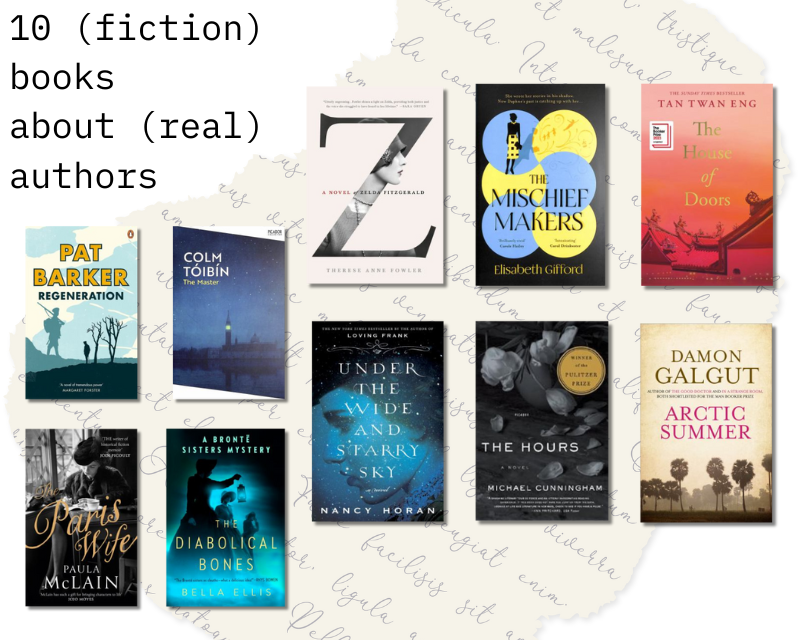10 fictional reads about real authors

The Craiglockhart War Hospital Edinburgh housed, amongst others, the poets Siegfried Sassoon and Wilfred Owen as they recuperated after World War 1. The novel delves into the ethical dilemmas of treating shell shock, the conflict between duty and conscience, and the profound impact of war on the human psyche, portraying the struggle to reconcile personal beliefs with societal expectations, and the fragile nature of mental resilience in the face of unimaginable horror.
The Paris Wife by Paula McLain
Set against the vibrant backdrop of 1920s Paris, The Paris Wife captures the passionate yet increasingly strained, relationship between Hadley Richardson and Ernest Hemingway. Hadley, initially naïve and devoted, navigates Hemingway's burgeoning literary career and the bohemian lifestyle of the Lost Generation but finds a gradual erosion of their bond caused by Hemingway's growing ambition and infidelities. The narrative highlights Hadley's sacrifices and the bittersweet reality of loving a genius, capturing the heartbreaking dissolution of a once-promising love story.
Tóibín explores Henry James's years of self-imposed exile, his unfulfilled desires, and the quiet melancholy that permeated his existence. Delving into his relationships, his literary dedication, and the subtle nuances of his genteel world, offering a poignant portrait of a man wrestling with his own identity. A portrait of a master, not just of literature, but of restrained emotion.
The Diabolical Bones by Bella Ellis
Haworth Parsonage, 1846, Yorkshire, Anne, Emily, and Charlotte are busy writing when a perplexing death disrupts their quiet lives. The sisters, each possessing unique skills and sharp minds, embark on a thrilling investigation. Blending their literary world with a thrilling mystery, highlighting their unique bond and the constraints they faced as women, while weaving in elements of their real lives and writings.
In the glittering, yet corrosive, world of Zelda and F. Scott Fitzgerald, Fowler paints a vivid portrait of their Jazz Age romance, a whirlwind of extravagant parties and artistic ambition, shadowed by Zelda's burgeoning mental fragility. From Zelda's perspective we experience her fierce independence and thwarted creative desires, often overshadowed by her husband's literary fame. Exploring the complex interplay of love, jealousy, and artistic rivalry, the intoxicating highs and devastating lows of their relationship that ultimately defined their tragic, iconic story.
Under the Wide and Starry Sky by Nancy Horan
Robert Louis Stevenson's life was shadowed by illness yet illuminated by a fierce love for his wife Fanny, his literary passion intertwining with the raw, often turbulent, emotions of their unconventional marriage. From bohemian Europe to the remote beauty of Samoa, the couple travel, a restless search for health and belonging. Fanny, a fiercely independent woman, becomes both muse and anchor, navigating his fragile health and artistic fervor.
The Mischief Makers by Elisabeth Gifford
Haunted by J.M. Barrie's looming presence, Daphne du Maurier teeters on the edge, her marriage strained by a destructive affair. As she writes, fiction bleeds into reality, with "Rebecca" mirroring her husband's past. Struggling to reconcile duty and desire, she confronts the dark undercurrents of Barrie's work and her own fame.
The Hours by Michael Cunningham
Virginia Woolf, in 1920s England, battles mental illness while writing "Mrs. Dalloway." Laura Brown, an American housewife in the 1950s reads the book while yearning for escape from her prescribed domestic role. And in contemporary New York City, Clarissa Vaughan, decides she will get the flowers herself. Cunningham reimagines three women in three different eras, reflecting Woolf's seminal novel.
The House of Doors by Tan Twan Eng
Tan Twan Eng weaves a fictional encounter between Somerset Maugham and colonial housewife Lesley Hamlyn in 1920s Penang. Maugham has come to British Malaya with his secretary and lover Gerald to recover from TB and find inspiration but finds himself drawn into Lesley's scandalous story, a tale of forbidden love and murder. Eng's languid prose perfectly reflects the atmosphere of the colonial elite at the time.
Galgut explores E.M. Forster's inner life, particularly his struggles with suppressed homosexuality and the complex relationships that influenced his writing. Detailing Forster's travels to India and Egypt, his encounters with men, and the emotional turmoil that shaped his masterpiece, "A Passage to India."

